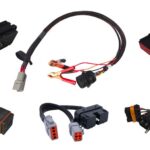Updating your car’s DME (Digital Motor Electronics) with ISTA (Integrated Service Technical Application) can seem daunting. This article clarifies the process, addressing common concerns and misconceptions about DME updates, particularly regarding OBD (On-Board Diagnostics) unlocking and tuning.
Understanding DME Updates and ISTA
ISTA is the official BMW software used by dealerships for diagnostics, programming, and coding. A DME update through ISTA often involves updating various control unit software, including the engine control unit. This process ensures optimal performance, addresses potential issues, and incorporates the latest features and improvements from BMW. However, there are concerns amongst enthusiasts about how these updates affect tuned vehicles or those with unlocked DMEs.
DME Encryption and Bootloaders: Separating Fact from Fiction
Contrary to popular belief, a standard DME update via ISTA is unlikely to overwrite existing DME software or lock a previously unlocked DME, especially in vehicles manufactured before March 2020. Most cars received updated software around that time due to an emissions recall. The confusion arises from the different layers within the DME:
- Bosch/Infineon Bootloader: This foundational layer is applied at the factory and governs basic ECU functionality.
- BMW Bootloader: This layer allows communication and programming with BMW diagnostic tools like ISTA. The “OBD lock” refers to restrictions within this bootloader.
- DME Software: This is the actual code controlling engine operation. Updates here often improve performance, fuel efficiency, and emissions.
- EEPROM Data: This stores vehicle-specific information like VIN, mileage, and adaptations.
The crucial distinction lies in the Bosch/Infineon bootloader. Post-June 2020, a new version of this bootloader prevented unauthorized modifications by closing a backdoor used for bench unlocking and flashing modified software. This change primarily impacted the ability to tune vehicles manufactured after June 2020.
Simplified representation of DME components
Pre-June 2020 Vehicles: Less Cause for Concern
For vehicles produced before June 2020, even with newer DME software (e.g., 2021 firmware), the BMW bootloader generally remains unlocked after an ISTA update. This means existing tunes and OBD unlocks are usually preserved. A full DME flash, which could overwrite modifications, requires special authorization and is rarely performed during routine service.
Example of an ISTA screen during a DME update process
Post-June 2020 Vehicles: Proceed with Caution
Vehicles manufactured after June 2020 have the updated Bosch/Infineon bootloader, making them more resistant to tuning and OBD unlocking. A DME update on these vehicles won’t necessarily lock a previously unlocked DME, but it could complicate future modifications.
Tuning Considerations and Best Practices
If your vehicle is tuned with software like BM3, it’s crucial to consult with your tuner before and after any DME update. They can advise on compatibility and potentially adjust your tune to work with the updated software. Clearing your tuning account before a DME update is often recommended. This allows for a clean installation of updated OTS (Off-The-Shelf) maps.
Example of a BM3 tuning software interface
Conclusion
Updating your DME with ISTA is generally safe and beneficial, especially for pre-June 2020 vehicles. Understanding the nuances of DME architecture and the implications of different bootloader versions can help alleviate concerns regarding tuning and OBD unlocking. Always consult with a knowledgeable tuner or BMW specialist if you have any questions or concerns about updating your DME. Keeping your software current ensures optimal performance and allows your vehicle to benefit from the latest advancements in engine management technology.


